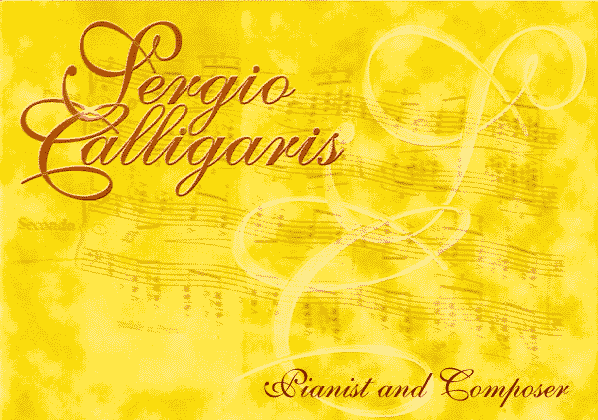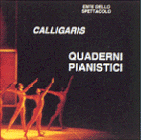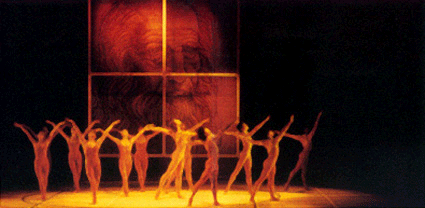
Sergio Calligaris
The author and performer's recordings
1. "IL QUADERNO PIANISTICO DI RENZO", op.7 (1978)
(Ed.Carisch) 8'59" A composer works mainly with his own materials: this is the minimum of coherency that can be asked of him. Sergio Calligaris declared what his were right from the first item of his production Renzo's Piano Notebook (this is his op.7: but nothing is known about his previous six works): the interval of fourth, chromaticism and rhythmic ostinato. The elements preferred must be included in designs of severe counterpoint, encompassed in most graceful, singing, melodic lines. In his favourite field of piano music, moreover - and this is quite normal, Calligaris being a pianist before being a composer - there is one further predilection: alternated octaves, preferably inserted in very wild runs. The composer's twin souls, the elegiac and the dithyrambic, gaze at each other from a distance, never meeting, although both are nourished by the same substance. Obviously with the exception of pages inspired to revivals of musics by others: the beloved Vivaldi or Tchaikovsky or, as here in BHS, Bach, Haendel, D.Scarlatti, where affection for beloved subjects cannot superimpose them its materials but restricts itself in drawing smiling metaphors with slight irony. Besides, strong wide pictures. On the one hand the discretion and the calm, dreamlike development of the Three Madrigals on texts by Giovan Battista Strozzi [they are fully reproduced and paraphrased at the bottom of page, Editor's note], where worthless are poet's appeals to "spaventose ombre e larve atre" ("frightening shades and dark shadows"), nor the memory of "voci dolorose" ("sorrowful voices"), nor the lovely invocation to the eternal night; but in the completely abstract outline, only the conquest of elegy counts. Poet's fear renders with repetitions of words as "ombre" ("shades") or "atre" ("dark"), but only to reach a "oh" added by the musician, which drags a child amazement along a chromatic sloping (and how many other equally amazed, powerless "oh" comment on Strozzi!). On the other hand, the wild beating of drums that starts the ferocity of the Requiem (violent series of superimposed fourths in one piano against the alternated octaves in the other), with the choir proposing again the absolute detachment of gregorian chant of "Agnus" or "Libera me". A compressed, repressed chant by a frenzy of good feelings revealing without modesty, ad memoriam mother, son's sorrow and tears. Intermediate ways are excluded. The Notebook is indicative in the clearcut opposition of the two levels: two dithyrambic pages against eight elegiac (including also objects as carillon, which under a hasty cascade of notes hide the aspiration to the childhood crystal clear tinkling). Not one of the ten numbers mingles the composer's two souls. Even exemplary the opposition in Prelude Sarabande and Finale, where the two extreme dithyrambic movements, perfectly homologous in outline, aspiration, importance and technique contain in perfect symmetry the delicate Sarabande (in which the author quotes himself using the Nocturne from the Notebook). There is just one feature, in ten years of composing, that Calligaris cannot count among those to which his coherency is due: being untopical. His precise, clear, "cantante" themes could have made him appear so ten years ago. Today the annals of history include him simply among the many who salvage some slice of the past: but they give him a singular right of primogeniture. It is not only his liking for singing, or fondness for tonality; it is his drawing on clear sentiments, his constancy in not failing back in the face of communication devoid of complexity, and indeed encouraging it. The complexity of certain pages is only apparent: once one has identified the module which, repeated in long progressions, determines the ostinato, and with its phonic weight and its riot of alternated notes determines the technical frenzy, the clear, simple, even severe structure of the music appears evident. And in the end precisely that basic severity is the element that resolves the dialectic of the two extreme expressions, the elegy and the dithyramb, as the only two possible epiphanies of materials chosen and investigated all life long. Michelangelo Zurletti "RENZO'S PIANO NOTEBOOK" op.7 (1978) is formed of ten short pieces for piano solo and is dedicated to Renzo Arzeni, musician of great sensitivity, bosom friend of the composer. "It's a collection - the author says - of evocative sense and it wishes to recall Bartok's "Microkosmos": it's the past of a pianist who, from the first notes played in the central register, goes and explores all sound and technical possibilities of the instrument in an increase of difficulty culminating in the final piece, of high virtuosity". By now, this composition has been performed all over the world and is part of the repertoire of many famous pianists. "BHS" op.20 (1984), divertissment on music by Johann Sebastian Bach, Georg Friedrich Haendel and Domenico Scarlatti for two pianos and women's voices, is regarded by its author "revival, with bitonal and polytonal harmonic hints, of the following compositions: Bach - Prelude and Fugue nr.2 from 1st Vol. of The well-tempered Clavier; Haendel - Ombra mai fu, from Xerses (Air); D.Scarlatti - Sonata in C. What mainly stands out in them is the brilliant virtuosity, not humorous but affectionately ironical. In the piece taking Haendel's composition as its starting point, a countersong establishes in the piano and superimposes on the vocal theme". "PRELUDE, SARABANDE AND FINALE" op.14 (1980) for piano solo was commissioned to the author by pianist Marcella Crudeli, to whom the work was subsequently dedicated, who performed it for important concert societies in several countries. "It's composed - the author says - of a first piece, Prelude, dramatically virtuosistic and with a strong dynamic tension: it has a first wide and rhapsodic theme and a second one, given out in low-pitched register, with strong rhythmic accents treated in a way of "Passacaglia". The second piece, Sarabande, is melancholy and developed on a contemplative theme. The Finale, from arpeggios and chords in fortissimo sets out again, triumphally, the first theme of Prelude". "INTERLUDIO, AGNUS DEI AND LIBERA ME" FROM REQUIEM op.17 (1982-83) for solos, choir, two pianos and timpani was composed ad memoriam composer's mother and is divided into eight movements. "The entire composition is based on a wide number of themes being transformed, varied and developed continuously, giving rise to a sort of cyclic form". The Interlude, purely instrumental, has a very violent rhythmic and dynamic writing; it
sets out again themes from Offertorium, Lacrimosa and, at the same time, discloses
variously next theme of Agnus Dei for men's voices only, with intimate and sad character. (All these selections were recorded live, with system "Digital", by Studio "A" of Vatican Broadcasting Company, on March 5th, 1986, at Auditorium in Via della Conciliazione, Rome - Technician of sound Ulderico Merluzzi). "THREE MADRIGALS" (1979). They draw their inspiration from texts by
the great Renaissance madrigalist Giovan Battista Strozzi, from Florence. Calligaris
himself comments on his own work: "I put these three Madrigals in a sequence to
recall the form of classical Sonata, that is an Allegro moderato as first, a Lento as
second and an Allegro (Gigue) as third. MARCELLA CRUDELI Giovan Battista Strozzi First Madrigal (XVII) Second Madrigal (IV) Third Madrigal (VIII)
|
Edited by Renzo
Trabucco: Page updated to 21/09/2000
Materials©Nuova Carisch s.r.l.

